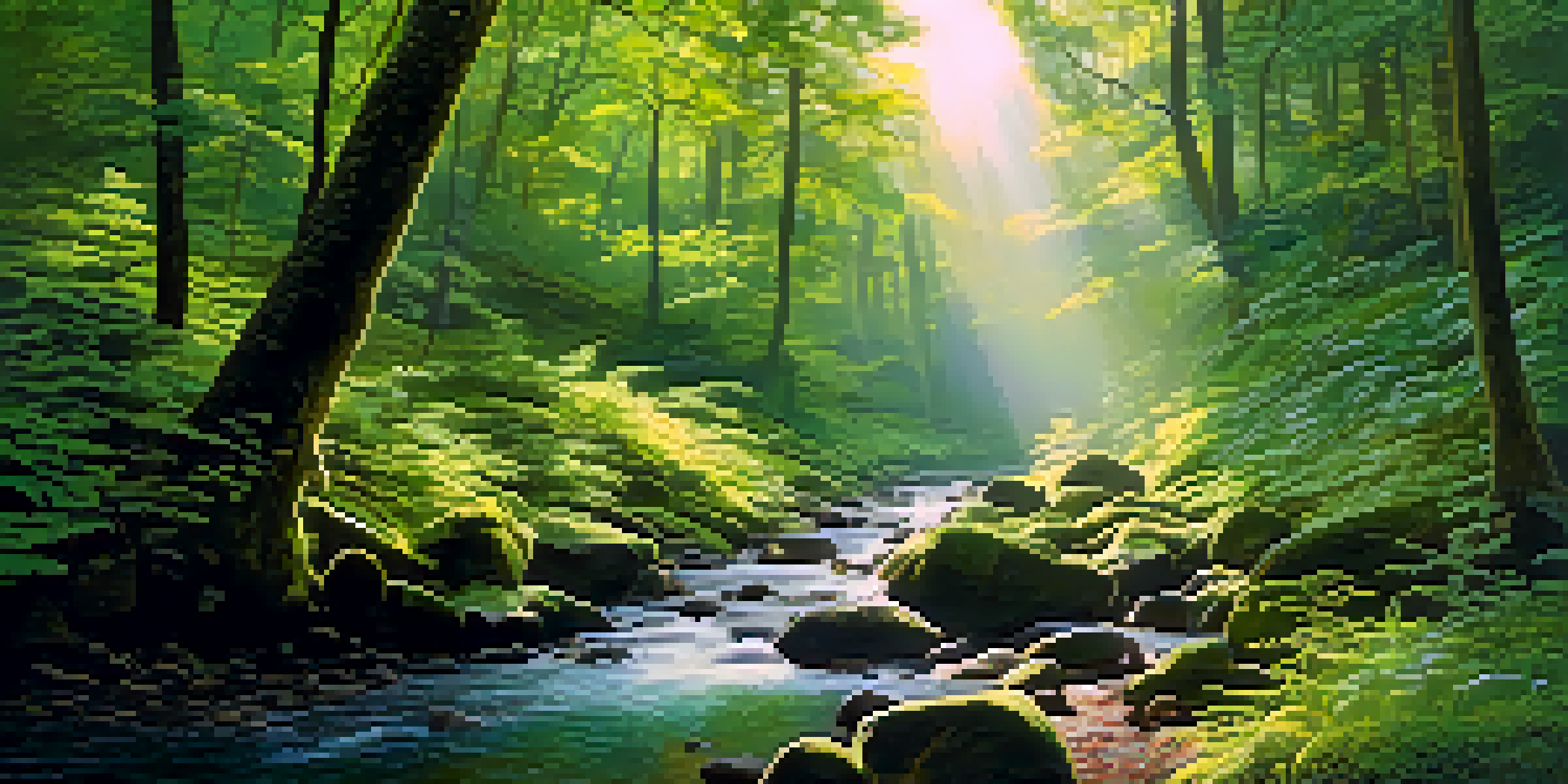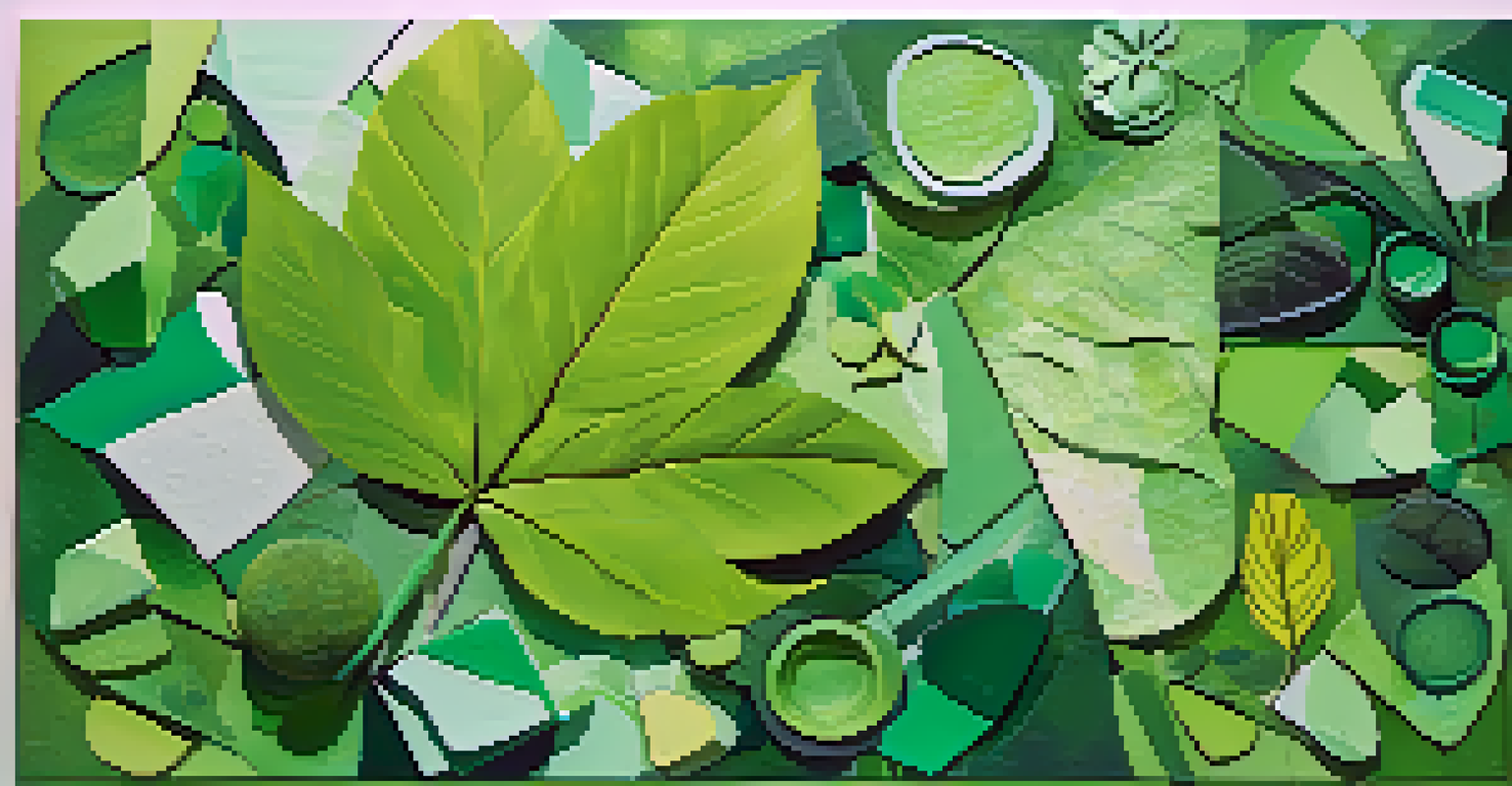Green in Art: The Connection to Nature and Balance

The Symbolism of Green in Artistic Expression
Green is often associated with nature, representing growth, renewal, and life. Artists have harnessed this color to evoke feelings of tranquility and harmony. For instance, in landscapes, green hues can create a sense of lushness and vitality, drawing viewers into the natural world.
Colors are the smiles of nature.
This connection between green and nature can be traced back to historical art movements. From the Impressionists who celebrated the beauty of outdoor scenes to contemporary artists using vibrant greens to convey environmental themes, the color has remained a staple in artistic expression.
Ultimately, green serves not just as a color, but as a powerful symbol of balance in our relationship with nature, reminding us of the beauty that surrounds us.
Nature's Influence on Artistic Techniques and Styles
The presence of nature in art has led to the development of various techniques that highlight the color green. For example, the use of layering and glazing can produce rich, textured greens that mimic the complexity of foliage. Artists often experiment with different shades and tones to convey the changing seasons and moods of nature.

Another technique is the use of natural materials in art-making. Some artists incorporate organic pigments derived from plants, which not only strengthens the connection to nature but also enhances the vibrancy of the green hues used in their work.
Green Symbolizes Nature and Renewal
Green represents growth and harmony, making it a fundamental color in artistic expression that evokes feelings of tranquility.
These artistic methods reflect a deep respect for the environment, showcasing how nature not only inspires creativity but also influences the very materials artists choose to employ.
Green in Art History: A Journey Through Time
Throughout art history, the color green has played a pivotal role in various cultures and movements. In ancient Egypt, green symbolized fertility and rebirth, often seen in art depicting the god Osiris. Similarly, during the Renaissance, green was used to represent hope and renewal in religious paintings.
Nature always wears the colors of the spirit.
In the 19th century, the Romantic movement embraced green as a way to escape the industrial world, celebrating nature's beauty in works like those of Caspar David Friedrich. This period marked a significant shift, where artists began to prioritize emotional responses to nature, further embedding green in the art narrative.
As we move into modern and contemporary art, green continues to evolve, reflecting societal issues like environmentalism, thus ensuring its relevance in today's artistic dialogue.
The Psychological Impact of Green in Artistic Works
Green is not just visually striking; it also has psychological effects on viewers. Studies have shown that being surrounded by green can reduce stress and promote feelings of calm. Artists often use this knowledge to create spaces that invite relaxation and contemplation.
For instance, many healing environments incorporate green art to enhance well-being. Hospitals and wellness centers feature artwork with green tones to help patients feel more at ease, demonstrating the power of art in influencing mood.
Art Techniques Highlight Green's Richness
Artists use layering and natural materials to create textured greens, emphasizing their deep connection to nature.
This psychological connection makes green a valuable tool for artists looking to convey specific emotions or themes, enriching the viewer's experience and interaction with their work.
Green as a Symbol of Environmental Awareness
In recent years, green has become synonymous with environmental awareness and sustainability. Artists are increasingly using their work to highlight ecological issues and the importance of preserving our planet. This trend has led to a resurgence of interest in eco-art, which often prominently features green elements.
Works that utilize recycled materials or depict nature's fragility serve as powerful reminders of our responsibility to the Earth. By incorporating green into their art, these creators foster a connection between the viewer and the environment, urging us to reflect on our actions.
This movement not only showcases the versatility of green in art but also reinforces the idea that art can be a catalyst for change, inspiring viewers to take action in their own lives.
The Role of Green in Contemporary Art Movements
In contemporary art, green continues to play a vital role across various movements. From abstract expressionism to street art, artists are exploring the nuances of green in innovative ways. The versatility of this color allows for a wide range of interpretations, making it relevant in today’s diverse art scene.
Moreover, many contemporary artists are challenging traditional perceptions of color by using unconventional shades of green to provoke thought and evoke emotions. This experimentation not only pushes artistic boundaries but also encourages viewers to engage with the work on a deeper level.
Green Promotes Environmental Awareness
In contemporary art, green serves as a symbol for sustainability and ecological consciousness, urging viewers to reflect on their relationship with the environment.
As artists continue to reinterpret green, it remains a powerful tool for commentary and expression, bridging the gap between nature and modern life.
Conclusion: Embracing Green for Balance and Connection
The color green holds a unique place in the world of art, serving as a bridge between humanity and nature. By embracing green, artists can create works that resonate with viewers on multiple levels, fostering a sense of connection and balance. This connection is essential as we navigate an increasingly urbanized world.
As we reflect on the significance of green in art, it's clear that this color offers more than aesthetic appeal; it embodies themes of growth, harmony, and environmental consciousness. Artists have the power to inspire change through their depictions of green, urging us to appreciate and protect the natural world.

In a time when environmental issues are at the forefront, the artistic exploration of green takes on even greater importance, reminding us of our responsibility to maintain balance with nature.